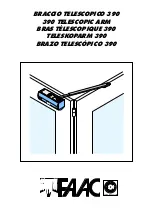
8. TROUBLESHOOTING
Original Language Version
© Jack Sealey Limited
Sealey Group, Kempson Way, Suffolk Business Park, Bury St Edmunds, Suffolk. IP32 7AR
01284 757500
01284 703534
www.sealey.co.uk
ENVIRONMENT PROTECTION
Recycle unwanted materials instead of disposing of them as waste. All tools, accessories and packaging should be sorted, taken to
a recycling centre and disposed of in a manner which is compatible with the environment. When the product becomes completely
unserviceable and requires disposal, drain any fluids (if applicable) into approved containers and dispose of the product and fluids
according to local regulations.
WEEE REGULATIONS
Dispose of this product at the end of its working life in compliance with the EU Directive on Waste Electrical and Electronic Equipment
(WEEE). When the product is no longer required, it must be disposed of in an environmentally protective way. Contact your local solid
waste authority for recycling information.
REGISTER YOUR
PURCHASE HERE
Note
: It is our policy to continually improve products and as such we reserve the right to alter data, specifications and component
parts without prior notice. Please note that other versions of this product are available. If you require documentation for alternative
versions, please email or call our technical team on [email protected] or 01284 757505.
Important
: No Liability is accepted for incorrect use of this product.
Warranty
: Lifetime guarantee on Transformer - Comprises 1 year unconditional parts and labour on all parts, followed by a lifetime
guarantee (parts and labour) conditional on registering your purchase with us online at www.sealey.co.uk.
PROBLEM
POSSIBLE CAUSE
REMEDY
Weld current interrupted.
Overheating protection activated due to overload.
Protection automatically resets when transformer has cooled (approx. 15 mins).
No weld current, fuse blowing in 13amp plug.
Rectifier blown.
Replace rectifier.
No weld current.
Bad connection between clamp and workpiece.
Clean or grind contact surface and weld area.
Break in earth lead.
Repair or replace earth lead.
Break in torch lead.
Repair or replace.
Feed motor not working.
Gear damaged or worn.
Replace gears (Section 6.7).
Motor defective.
Replace motor (Contact service agent).
Wire does not feed, feed roller rotates.
Pressure roller improperly adjusted.
Adjust wire tension. (Section 3.6).
Dirt, copper, dust, etc. have collected in torch liner.
Clean the liner from the machine forward. Use compressed air. If too much dirt,
replace the liner (Sections 6.2 & 6.6).
Gas cup (nozzle) or tip defective.
Replace gas cup (nozzle) and/or tip (Sections 6.3 & 6.4).
Deformed wire.
Check roller tension (Section 3.6).
Wire feeds unevenly.
Dirt, etc, in liner.
Clean the liner from the machine forward using compressed air.
Gas cup (nozzle) or tip defective.
Replace gas cup (nozzle) and/or tip (Sections 6.3 & 6.4).
Gas cup (nozzle) spattered.
Clean or replace gas cup (nozzle) (Sections 6.3 & 6.4).
Feed roller groove clogged.
Clean feed roller (Sections 6.1 & 6.5).
Feed roller groove deformed.
Replace feed roller (Section 6.5).
Pressure roller tension incorrect.
Adjust tension (Section 3.6).
Unstable arc.
Incorrect settings.
Check settings (Section 3.7).
Impurities in weld area.
Clean and/or grind workpiece (Section 4.2.1).
Worn or defective gas cup (nozzle).
Replace gas cup (nozzle) (Sections 6.3 & 6.4).
Porous weld.
No gas.
Open gas cylinder, regulate gas flow.
Gas cup clogged.
Clean or replace cup (Section 6.4).
Draft blowing away shielding gas.
Screen off welding site or increase gas flow.
Rusty/dirty joints.
Clean or grind the workpiece (Section 4.2.1).
Torch too far from, or at wrong angle to, workpiece.
Gas cup to workpiece should be 8-10mm. Torch angle approx 75°.
Gas leak.
Check hoses, connections and torch assembly.
Wire sticking in gas cup (nozzle).
Worn or defective gas cup (nozzle).
Replace gas cup (nozzle) (Section 6.4).
Wire deformed.
Check roller tension (Section 3.6).
Wire speed too slow.
Increase wire speed. (Section 3.7).
Irregular weld head.
Torch incorrectly held.
Use correct torch angle.
Wire weaving in weld pool.
Check roller tension and adjust (Section 3.6).
Weld bead too narrow and raised.
Weld current too low.
Increase power and wire speed (Section 3.7).
Weld speed too fast.
Move torch slower and weave a little more.
Weld bead too wide.
Weld current too low.
Increase current and wire speed (Section 3.7).
Weld speed too slow.
Move torch faster and weave less.
Poor penetration.
Weld current too low.
Increase current and wire speed (Section 3.7).
Arc too long.
Bring torch closer to workpiece.
Excessive penetration.
Weld current too high.
Decrease current and wire speed (Section 3.7).
Weld speed too slow.
Move torch faster.
Incorrect distance of torch to workpiece.
Torch distance should be 8-10mm.
S
UPERMIG140.V2 Issue:1 08/07/22
























